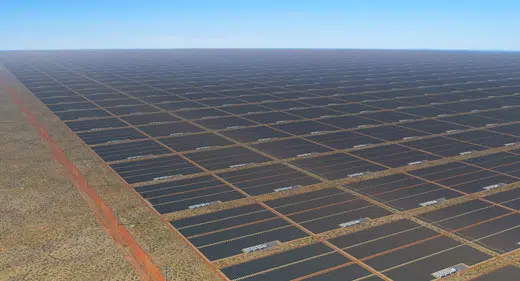With global emissions targets set for the coming decades throughout much of the world,
 it appears that many sustainability-oriented countries have begun making serious efforts to further build out their clean energy infrastructure. The situation has a lot of parallels to the Space Race of the mid-20th century. Both involved life-changing technological advancements – just as nations around the world competed over being the first to reach the moon 60-plus years ago, many of those same countries are now in that same pursuit of making a renewable energy generation system. One nation not to be overlooked is Singapore. While the island kingdom famous for its beautiful airports is still outpaced by many larger nations in terms of total solar energy output, a new partnership with Australia marks the beginning of a project unlike anything the world has ever seen.
it appears that many sustainability-oriented countries have begun making serious efforts to further build out their clean energy infrastructure. The situation has a lot of parallels to the Space Race of the mid-20th century. Both involved life-changing technological advancements – just as nations around the world competed over being the first to reach the moon 60-plus years ago, many of those same countries are now in that same pursuit of making a renewable energy generation system. One nation not to be overlooked is Singapore. While the island kingdom famous for its beautiful airports is still outpaced by many larger nations in terms of total solar energy output, a new partnership with Australia marks the beginning of a project unlike anything the world has ever seen.
Known as the Australia-Asia PowerLink, the huge solar infrastructure project is expected to cost an estimated $22 billion and will become the single largest solar construct ever attempted. That claim extends beyond Singapore and across the entire world. It is quite an undertaking for the kingdom, as Singapore’s entire gross domestic product is equal to that of the city of Hong Kong and roughly one-tenth of that of California.
Singapore won’t be able to do this all on its own. Since the island nation is already somewhat overdeveloped relative to the amount of available land, there isn’t nearly enough space for a solar farm of record-breaking proportions. As a result, the farm itself will be located off the island in Darwin, Australia. The Land Down Under is already famous for its ample availability of sunlight, which can burn up to 15 percent hotter than elsewhere in the world. As one would expect, this has led to the nation being among the leaders in solar energy capacity and has even seen energy production outpace total energy demand in its southern territory.
How does the solar power get from Australia to Singapore, then? While the energy harnessed in Australia could be stored in batteries and subsequently shipped across the sea, that process in itself would generate carbon emissions and contradict the entire point of the operation. What the nations have instead decided to do is create a transmission system comprised of undersea cables – nearly 3,000 miles of them. With cooperation from Indonesia, the plan is for the cables to be laid on the ocean floor and run through Indonesian territorial waters on their way to Singapore. Upon completion, an expected 3.2 gigawatts of energy will be transferred over the course of each year – enough to power 3 million homes and meet 15 percent of Singapore’s total energy demand.
Although the PowerLink will be the largest project of its kind, just how large it truly is can be mind-boggling when compared to existing solar projects. The closest existing structure in scope is currently the Bhadla Solar Park in India, which has a capacity of roughly one-tenth of the expected 20 gigawatts of PowerLink’s peak solar power generation. In the United States, the largest solar farm currently in operation is the Solar Star project – its almost 600 megawatts of capacity leaves PowerLink anywhere from 30 to 60 times larger in effect.
The project is made possible through a collaboration between the governments of Singapore, Australia, and Indonesia and will be facilitated by Sun Cable, an Australian power company. While it remains to be seen as to whether a project of this magnitude will be attempted in the U.S., a variety of similar agreements are underway between Mongolia and Japanas well as Northern Africa and several European countries.









































